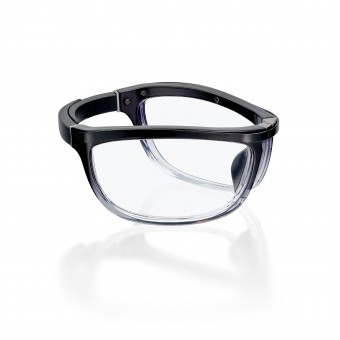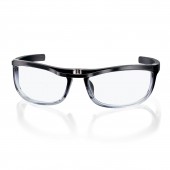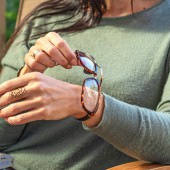EyeWris Reading Glasses by Kenzo Singer |
Home > Winners > #134394 |
 |
|
||||
| DESIGN DETAILS | |||||
| DESIGN NAME: EyeWris PRIMARY FUNCTION: Reading Glasses INSPIRATION: The idea for EyeWris began as a response to a need; specifically, the needs of my father and co-owner, Mark Singer. He needed a better solution to reading glasses, so that he could always have them with him. My background in structural engineering proved pivotal. As it turns out, physics at the scale of a skyscraper also applies to something as small as a pair of glasses. This unusual meeting of structure and eyewear resulted in the invention of the bi-stable bridge, which made EyeWris possible. UNIQUE PROPERTIES / PROJECT DESCRIPTION: EyeWris reading glasses wrap securely around the wrist so that they are always within reach, eliminating the daily frustration of not having reading glasses when needed. A balancing act of precise geometry and materials engineering, the world's first bi-stable nose bridge utilizes memory metal to both spring open and snap shut. EyeWris represents a meeting of timeless style and innovation, bringing brand new functionality and unparalleled convenience to a familiar product. OPERATION / FLOW / INTERACTION: On the face, the glasses are worn like traditional eyewear, with the exception of the "arms", which gently but securely grip the temples. On the wrist, the glasses function similarly to a bracelet. It takes one hand, one motion, and one second to change the glasses from wrist-wear to eyewear. The haptic experience of the folding mechanism truly brings the glasses to life. PROJECT DURATION AND LOCATION: The project started in 2017 in Santa Barbara, with fully functional prototypes completed in mid 2018. The design was continuously refined during the production prototyping process. Withstanding interruptions due to the global pandemic, the first production models were completed in November, 2021. |
PRODUCTION / REALIZATION TECHNOLOGY: Patented bi-stable bridge: nitinol memory metal in combination with precisely engineered geometry results in bi-stable spring behavior. Premium Lenses: polycarbonate lenses for best-in-class durability. Includes blue-light blocker, 100% UV protection, anti-scratch, anti-smudge, and anti-reflective coatings. Swiss-developed TR-90 frames: lightweight and extremely durable. Flexible temples engineered for comfort on both wrist and face. Minimum 25,000 open/close cycles SPECIFICATIONS / TECHNICAL PROPERTIES: 40mm x 40mm x 60mm (closed/wrist configuration) TAGS: EyeWris, eyewear, glasses, readers, reading glasses, folding, wrist RESEARCH ABSTRACT: Ergonomic research was applied to determine the optimal frame dimensions to fit 95% of human faces and wrists. Fatigue limits of nickel-titanium memory metal was critical to ensure that the bridge could open and close for at least 25,000 cycles. The heat treatment process for this part was also critical to optimize for the spring mechanism to function. For the lenses, due to the high base curve needed for ergonomics on the wrist, a proprietary solution was developed to mitigate optical distortion. CHALLENGE: The field of eyewear, having been around for centuries, has been thoroughly explored and optimized in terms of form and function. As a result, true innovation in eyewear is exceedingly rare and challenging to achieve. While the concept of "glasses on the wrist" is not new, the design challenges are such that it has never been well-executed. Looking back at the design process, with all the challenges along the way, the biggest hurdle was the first one: creating a brand new category of eyewear. ADDED DATE: 2022-01-07 08:37:34 TEAM MEMBERS (2) : Kenzo Singer and Mark Singer IMAGE CREDITS: EyeWris PATENTS/COPYRIGHTS: Patented. Patent No. 10175501. Kenzo Singer and Mark Singer. 2018. USA Patented. Patent No. 6833122. Kenzo Singer and Mark Singer. 2018. Japan Patented. Patent No. 2021070100181360. Kenzo Singer and Mark Singer. 2018. China. Patent Pending. Application No. 18840116. Kenzo Singer and Mark Singer. Europe. Copywright 2017-2021 Times 4, LLC. |
||||
| Visit the following page to learn more: http://eyewris.com | |||||
| AWARD DETAILS | |
 |
Eyewris Reading Glasses by Kenzo Singer is Winner in Jewelry Design Category, 2021 - 2022.· Press Members: Login or Register to request an exclusive interview with Kenzo Singer. · Click here to register inorder to view the profile and other works by Kenzo Singer. |
| SOCIAL |
| + Add to Likes / Favorites | Send to My Email | Comment | Testimonials | View Press-Release | Press Kit |







